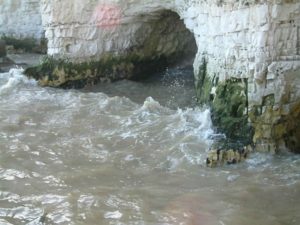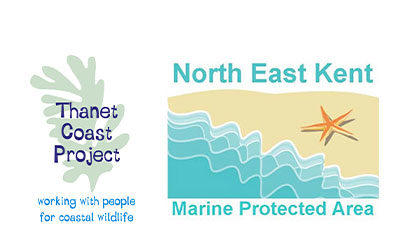The seaweeds of the Thanet Coast
What’s it all about – algae!
Unusual and interesting algae inhabit the chalk habitats along the Thanet Coast. Ian Tittley (British Natural History Museum) fills in the ‘wracks’:
“On cliffs, microscopic algae accumulate to form distinct coloured bands – bright orange growths (Chrysotila) may be seen high on the cliffs at levels that receive only splash and spray from the sea, while around the high tide level, you’re more likely to find a muddy brown band (Apistonema) just above a coating of larger green algae.

The dark, damp environment of caves attracts other algal species – with the walls and ceilings often stained with a green alga (Pseudendoclonium). A red velvety layer (Rhodochorton purpureum) or a golden brown velvety layer (Pilinia rimosa) may line the cave walls to a couple of metres above beach level. The algae on the rocky foreshore is uncovered during low water and are often much larger – commonly referred to as seaweed! Around 100 species are found in Thanet. Bladder Wrack (Fucus vesiculosus) and its sister Serrated Wrack (F.serratus) cover large areas, while the broad green fronds of Sea Lettuce (Ulva lactuca) occur in rock pools, together with the fine feather-like calcified growths (Corallina officinalis).

Near low tide level, red fronds of Dulse (Palmaria palmata) grow over the rocks and large brown Kelp fronds (Laminaria digitata, L. saccharina) are abundant at and below the low tide level.
Thanet is home to many different forms of algae and they all have many different uses. Seaweed was gathered from Thanet shores to use as manure, while in the past, Fucus and Laminaria were collected and burned to produce ‘Potash’, which was exported to Holland for use in glazing pottery. Every day we all use a product which comes from seaweed and it’s even in that seaside favourite – ice cream!”
(Article: Thanet Coast Newsletter 5)
Further information:
- Seaweed & their Secrets walk and talks are run over the summer months – information and bookings are on the events page
- Seaweed – the facts, its uniqueness, and its management and removal from the bathing beaches in the summer – see Thanet District Council’s:
- Beaches in Thanet – includes seaweed management
- Seaweed information (with FAQs, 2020)
- Thanet Council – Seaweed booklet (2023, PDF 3.5MB)
- Exploring Kent’s seaweed coast (ITV Meridian, Aug 2018)
- Seaweeds & their Secrets Exhibition: 25 July to 2 Sept, 2018, 10am-5pm (Margate Visitor Information Centre) created by Ian Tittley (Natural History Museum & Kent Field Club) with help from the Thanet Coast Project & NEKMPA Coastal Wardens. Poster (JPEG, 548KB)

